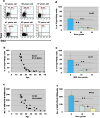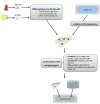Understanding nucleus pulposus cell phenotype: a prerequisite for stem cell based therapies to treat intervertebral disc degeneration
- PMID: 25584906
- PMCID: PMC4437858
- DOI: 10.2174/1574888x10666150113112149
Understanding nucleus pulposus cell phenotype: a prerequisite for stem cell based therapies to treat intervertebral disc degeneration
Abstract
Intervertebral disc (IVD) degeneration and associated low back pain (LBP) remains a major burden to our society without significant improvements in treatment strategies or patient's quality of life. While the recent cell-transplantation studies for treatment of degenerative disc disease have shown promising results, to better gauge the success and functional outcomes of these therapies, it is crucial to understand if transplanted cells give rise to healthy nucleus pulposus (NP) tissue. NP cell phenotype is unique and is defined by expression of a characteristic set of markers that reflect specialized physiology and function. This review summarizes phenotypic markers that mirror the unique physiology and function of NP cells and their progenitors and should be considered to when measuring outcomes of cell-based therapies to treat disc degeneration.
Figures


Similar articles
-
[Research situation of stem cells transplantation for intervertebral disc degeneration].Zhongguo Xiu Fu Chong Jian Wai Ke Za Zhi. 2013 May;27(5):575-9. Zhongguo Xiu Fu Chong Jian Wai Ke Za Zhi. 2013. PMID: 23879095 Review. Chinese.
-
Transplantation of activated nucleus pulposus cells after cryopreservation: efficacy study in a canine disc degeneration model.Eur Cell Mater. 2016 Jan 27;31:95-106. doi: 10.22203/ecm.v031a07. Eur Cell Mater. 2016. PMID: 26815642
-
Overview of Stem Cell Therapy in Intervertebral Disc Disease: Clinical Perspective.Curr Stem Cell Res Ther. 2023;18(5):595-607. doi: 10.2174/1574888X17666220628123912. Curr Stem Cell Res Ther. 2023. PMID: 35762555 Review.
-
Stem Cell Therapies for Intervertebral Disc Degeneration: Immune Privilege Reinforcement by Fas/FasL Regulating Machinery.Curr Stem Cell Res Ther. 2015;10(4):285-95. doi: 10.2174/1574888x10666150416114027. Curr Stem Cell Res Ther. 2015. PMID: 25381758 Review.
-
The nucleus pulposus microenvironment in the intervertebral disc: the fountain of youth?Eur Cell Mater. 2021 Jun 15;41:707-738. doi: 10.22203/eCM.v041a46. Eur Cell Mater. 2021. PMID: 34128534 Review.
Cited by
-
Control of adhesive ligand density for modulation of nucleus pulposus cell phenotype.Biomaterials. 2020 Aug;250:120057. doi: 10.1016/j.biomaterials.2020.120057. Epub 2020 Apr 22. Biomaterials. 2020. PMID: 32361392 Free PMC article.
-
In the presence of TGF-β1, Asperosaponin VI promotes human mesenchymal stem cell differentiation into nucleus pulposus like- cells.BMC Complement Med Ther. 2021 Jan 14;21(1):32. doi: 10.1186/s12906-020-03169-y. BMC Complement Med Ther. 2021. PMID: 33446173 Free PMC article.
-
Single-cell RNA-seq identifies unique transcriptional landscapes of human nucleus pulposus and annulus fibrosus cells.Sci Rep. 2020 Sep 17;10(1):15263. doi: 10.1038/s41598-020-72261-7. Sci Rep. 2020. PMID: 32943704 Free PMC article.
-
Intervertebral disc human nucleus pulposus cells associated with back pain trigger neurite outgrowth in vitro and pain behaviors in rats.Sci Transl Med. 2023 Dec 6;15(725):eadg7020. doi: 10.1126/scitranslmed.adg7020. Epub 2023 Dec 6. Sci Transl Med. 2023. PMID: 38055799 Free PMC article.
-
Characterization of Krt19 CreERT allele for targeting the nucleus pulposus cells in the postnatal mouse intervertebral disc.J Cell Physiol. 2020 Jan;235(1):128-140. doi: 10.1002/jcp.28952. Epub 2019 Jun 11. J Cell Physiol. 2020. PMID: 31187500 Free PMC article.
References
-
- Deyo RA, Weinstein JN. Low back pain. N Engl J Med. 2001;344(5):363–70. - PubMed
-
- Freemont AJ. The cellular pathobiology of the degenerate intervertebral disc and discogenic back pain. Rheumatology (Oxford) 2009;48(1):5–10. - PubMed
-
- Martin BI, Deyo RA, Mirza SK, et al. Expenditures and health status among adults with back and neck problems. JAMA. 2008;299(6):656–64. - PubMed
-
- Phillips FM, Reuben J, Wetzel FT. Intervertebral disc degeneration adjacent to a lumbar fusion. An experimental rabbit model. J Bone Joint Surg Br. 2002;84(2):289–94. - PubMed
Publication types
MeSH terms
Grants and funding
LinkOut - more resources
Full Text Sources
Other Literature Sources
Medical
Miscellaneous

